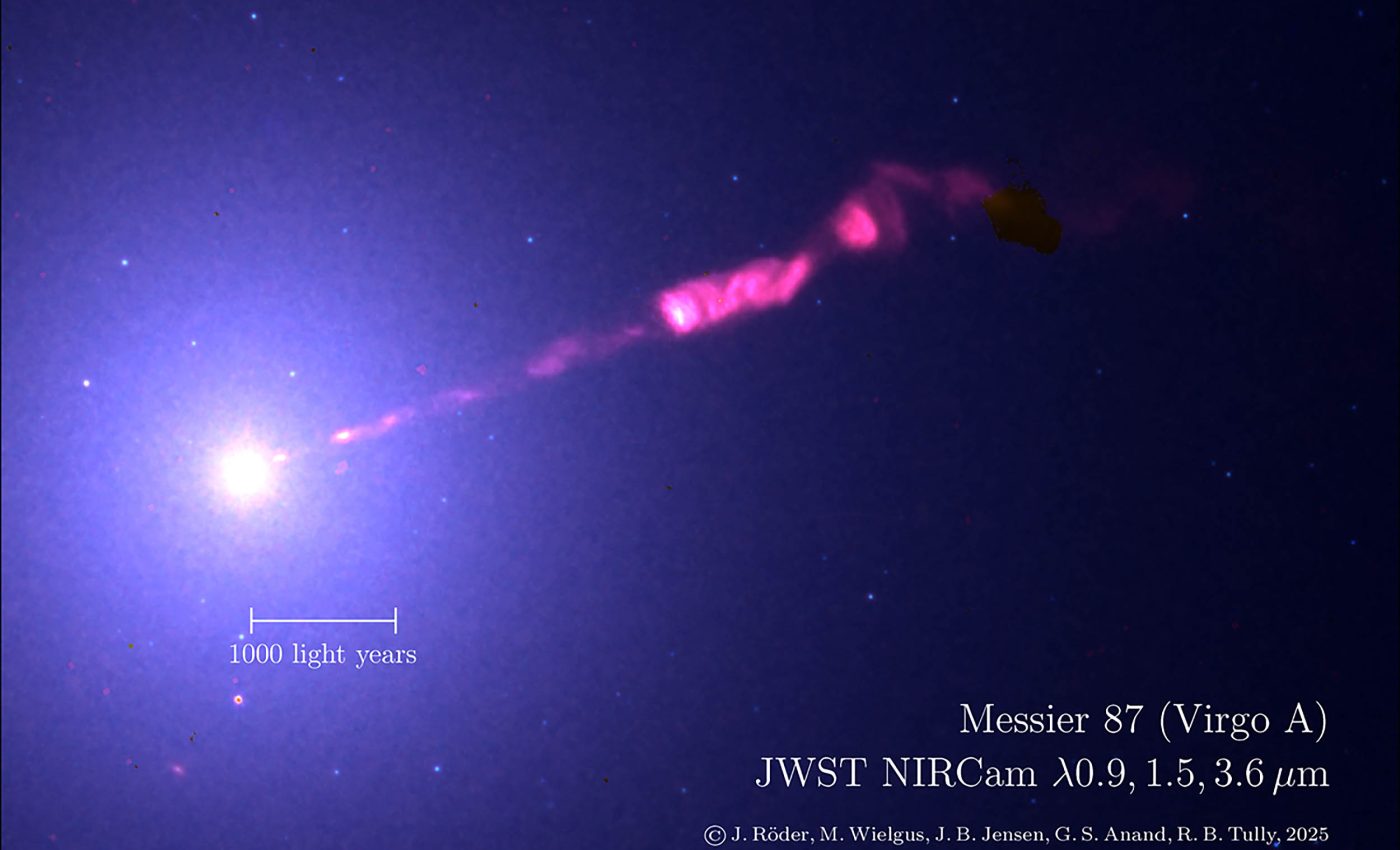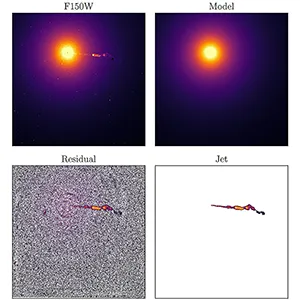
Webb captures incredibly detailed image of galaxy M87's black hole jet
A century after astronomers first spotted the colossal jet blasting from the black hole at the heart of the galaxy M87, a new look has brought it into startling focus.
Using infrared observations, researchers have traced bright knots and dark, helical lanes in unprecedented detail and, crucially, picked out the jet’s elusive counterpart on the far side of the black hole.
The research team, led by Maciek Wielgus at the Institute of Astrophysics of Andalusia, reanalyzed data from the James Webb Space Telescope (JWST) to map the jet structure and the much dimmer counter-jet that shoots away from us.
The analysis offers fresh clues about how these cosmic beams are shaped as they plow through surrounding gas.
Century-old M87 jet mystery
Heber Curtis first noticed the M87 jet in 1918 as a strange spike of light jutting from the galaxy’s core.
A hundred years later, the same supermassive black hole made history again when the Event Horizon Telescope released the first image of a black hole’s shadow.
Through it all, M87’s jet has remained a touchstone for understanding how a black hole launch and collimate streams of superheated plasma across tens of thousands of light years.
Even so, many features have resisted easy explanation. Some segments glow as bright knots, while others twist into darker, helix-like threads.
Astronomers have long suspected pressure changes and magnetic strand “recombination” as the jet plows into patchy, denser gas, but the details have remained murky.
Turning starlight into signals
JWST’s infrared sight is exquisitely sensitive to stars. That’s both a blessing and a problem for jet hunters.
In raw images, the galaxy’s glare can drown out the delicate, threadlike jet. The team solved that by stripping away the starlight, frame by frame, to reveal the faint structures beneath.
“It’s a very practical example of what astronomers often say, what is one astronomer’s trash is another astronomer’s data,” Wielgus told New Scientist.
What began as observations targeting M87’s stellar population became a high-contrast map of the jet itself.
The cleaned images capture the familiar bright features in sharper relief and lay bare the darker, corkscrew-like lanes that trace the jet’s internal structure.
Diamond patterns in M87 jet flow
One standout feature sits near the core and carries a name many Hubble fans will recognize: HST-1. That knot is thought to flare where the jet slams into a higher-pressure pocket and briefly “refocuses.”
The physics is akin to diamond-shaped shock patterns in a rocket exhaust – regions where pressure oscillates, compressing and brightening the flow before it relaxes again.
With JWST, those refocusing zones look crisper. They help diagnose how pressure and magnetic fields steer the beam and how the jet exchanges energy with the medium it crosses.
That, in turn, shapes how far a jet can travel and how much it heats and stirs a galaxy’s halo.

Both jets now mapped
The real prize lies on the far side. Black hole jets come in pairs: one points slightly toward us, the other points away. Special relativity plays a trick here.
When plasma races near light speed, emission beamed toward us appears brighter, while emission beamed away looks much dimmer. That’s why spotting M87’s counter-jet has been so difficult.
In the JWST data, the team traces the far-side jet to where it appears to break and spill into a region of different pressure. At that termination, the dim beam brightens enough to detect.
Combined with the nearer jet’s end, the two landmarks sketch the rim of a bubble of gas and plasma that cocoons M87.
The gas bubble is where the jet and the galaxy’s atmosphere meet. Its density and pressure determine where the beam tightens, where it flares, and where it finally dumps its energy.
With the counter-jet now pinned down in infrared, modelers can begin testing bubble shapes and gas profiles that fit both ends at once.
Magnetism and the plasma beam
Those darker, helix-shaped lanes that thread the beam are more than visual flourishes.
They likely trace magnetic fields wound around the jet like barber-pole stripes. Twisted fields can help confine the flow and prevent it from splaying apart.
They can also reconnect and release bursts of energy, perhaps igniting the bright knots downstream. Seeing both the intensity pattern and the geometry in one dataset gives theorists a firmer target to test.
Jets shape galaxy evolution
Jets are more than pretty fireworks. They regulate how galaxies grow. By heating and stirring gas in and around a galaxy, a single jet can trigger new stars in some regions and quench star formation in others.
M87’s jet is a laboratory for all of that physics, close enough and bright enough to pick apart. Webb’s view adds missing pieces. It sharpens the near-side structure. It teases out the far-side counterpart.
And it ties both to the larger, bubble-like envelope that surrounds the galaxy. With those anchors, simulations can explore how strands merge, how shocks form, and how the beam loses energy as it crosses a messy, multiphase medium.
There’s also a lingering mystery about the jet’s origin point. The jet should launch along the black hole’s spin axis and the inner disk’s magnetic scaffold.
Pinning the near-core geometry more precisely could help resolve why different instruments sometimes suggest different viewing angles for the black hole itself.
Plasma flow and M87 jets
In future research, JWST can revisit the jet at multiple infrared wavelengths to map dust and warm gas along the beam.
X-ray observatories can trace the hottest plasma, including the regions where shocks accelerate particles.
Radio arrays can chart magnetic fields and see how the jet’s spine and sheath move relative to each other. Together, those layers can turn JWST’s snapshot into a time-evolving portrait.
For now, M87 has given up a secret that hid in plain sight: the faint end of a twin beam racing away from us. With that landmark secured, the galaxy-scale weather system it powers is finally ready for a full forecast.
The study is published in the journal Astronomy & Astrophysics.
—–
Like what you read? Subscribe to our newsletter for engaging articles, exclusive content, and the latest updates.
Check us out on EarthSnap, a free app brought to you by Eric Ralls and Earth.com.
—–













